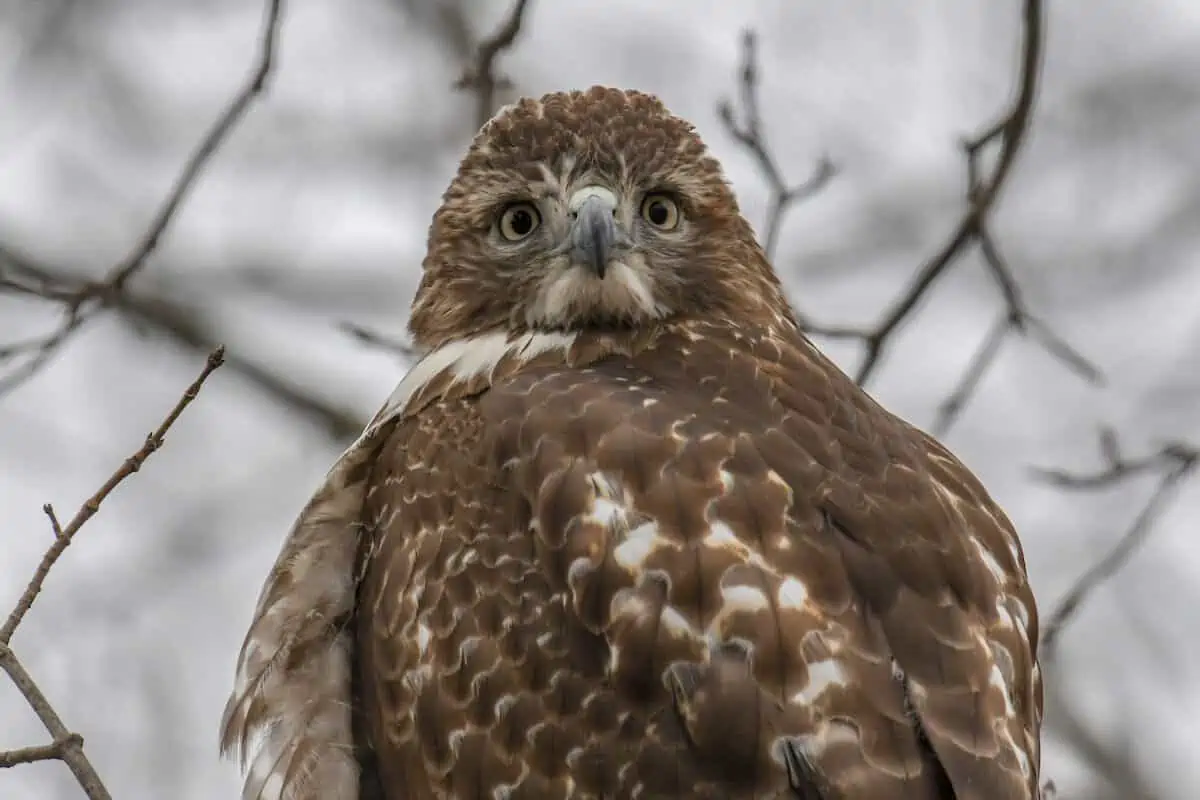The carnivorous family of hunting birds known as birds-of-prey includes hawks. Their acute hearing and vision, as well as their keen beak and talons, combine to make them exceptional predators. Hawks live in diverse climates throughout the United States, with roughly 16 species. However, we aim to cover the eight species of hawks present in Wyoming as well as a ninth species that is similar to them.
8 HAWKS IN WYOMING
Cooper’s hawk, ferruginous hawk, northern goshawk, northern harrier, red-tailed hawk, rough-legged hawk, sharp-shinned hawk, and Swainson’s hawk are the eight species of hawks that may be found in Wyoming.
Let’s take a look at each one.
1. COOPER’S HAWK

Scientific name: Accipiter cooperii
Length: 14.6 – 17.7 in
Weight: 7.8 – 24.0 oz
Wingspan: 24.4-35.4 in
Cooper’s hawks may be found year-round in Wyoming, and may be found across most of North America. Adults have a red eye and a squared-off head with a black cap. They have a bluish-gray back and heavy orange barring on the chest. The eyes of immature birds are yellow, the back is brown, and the underparts are white with deep brown streaks.
Forests and woodlands are their preferred habitats, but they seem to be comfortable in the suburbs as well. Little birds are their primary source of nourishment, and they detect them with ease in the tree canopy. The Cooper’s hawk is a common sight in people’s yards, where it has been known to attack birds on a bird feeder, particularly starlings, doves, and pigeons.
Cooper’s hawk skeletons show that several of them had previously broken bones in their chest after colliding through trees and foliage on a fast pursuit after birds.
2. FERRUGINOUS HAWK
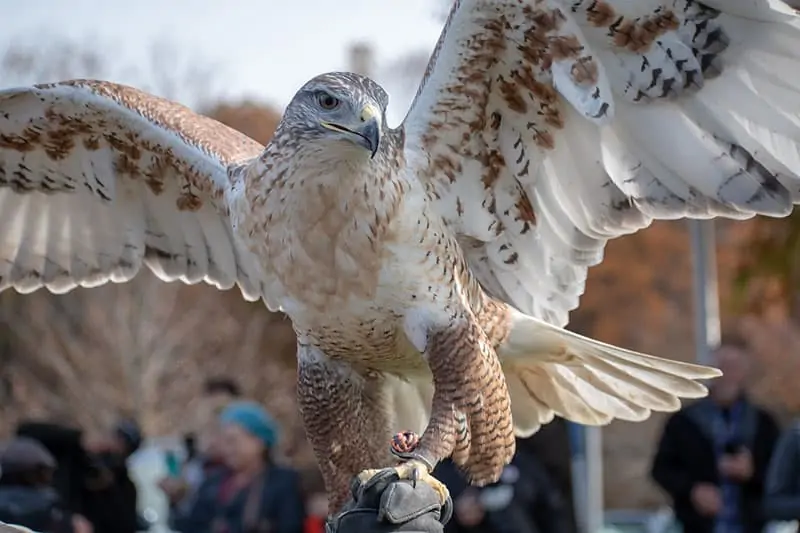
Length: 22.1-27.2 in
Weight: 34.5-73.2 oz
Wingspan: 52.4-55.9 in
Throughout the spring and summer, Ferruginous Hawks visit Wyoming to breed. They soar over fields and plains, hunting on the ground or seeking out tiny animals, and they prefer to stay in open areas like this.
The biggest North American hawks are these hawks. Their rusty red plumage on their backs, shoulders, underwings, and legs earned them their name. They have gray streaked heads with white underparts.
Prairie dogs are ambushed by Ferruginous Hawks in groups of 5-10. Before attacking, they perch and wait for prey to emerge from their holes. When the hawks begin hopping and flapping their wings, which is a common sight, they attract other birds of prey.
3. NORTHERN GOSHAWK

Scientific name: Accipiter gentilis
Length: 20.9-25.2 in
Weight: 22.3-48.1 oz
Wingspan: 40.5-46.1 in
The back of goshawks is gray, and there’s a black stripe that runs the length of each eye. The chest is barred with black on the underside. The sharp-shinned and cooper’s hawk are regarded as their larger and fiercer cousins. Goshawks, on the other hand, are quiet and generally stay in the forest, avoiding human populated areas. They are not like those hawks that are prevalent in backyards.
Throughout the non-breeding season, Northern Goshawks may be observed across most of Wyoming, however they are more commonly visible along the eastern border. However, since they prefer to nest in old-growth forest with thick canopy, finding one will be difficult. Humans who get too close to their nests have been known to be attacked. Therefore, when looking for these raptors during the breeding season, be cautious.
Little hawks, birds, mammals, reptiles, and even insects and carrion make up the varied diet of the northern goshawk. Because of their secretive nature, they are considered uncommon and their population is difficult to estimate.
4. NORTHERN HARRIER

Scientific name: Circus hudsonius
Length: 18.1-19.7 in
Weight: 10.6-26.5 oz
Wingspan: 40.2-46.5 in
The face of the northern harrier is almost owl-like. This disc-shaped feature, which directs sound into the ears of these creatures to aid them sight and hear, operates similarly to an owl. The length of their tail and the white patch above it are two helpful identifying features. Their flying style is known for its unique form, which they keep their wings in. These birds are described as majestic by many people.
This hawk can be found in Wyoming year-round. In wide-open areas such as marshes, fields, and so on, you’re likely to see them.
This hawk creates a platform on the ground in thick vegetation, such as reeds, willows, sedges, and cattails, unlike many hawks that nest in trees. Males can have two (and occasionally more) simultaneous mates, providing for the female and her offspring.
5. RED TAILED HAWK
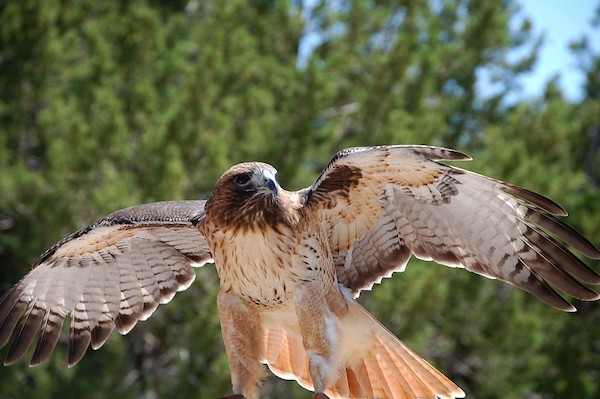
Scientific name: Buteo jamaicensis
Length: 17.7 – 25.6 in
Weight: 24.3oz – 51.5 oz
Wingspan: 44.9-52.4 in
The most widespread hawk on the continent of North America, red-tailed hawks live in practically every state year-round. Summer residents, with some in the far west and south staying put all year, are the majority in Wyoming.
The most active period for red-tailed hawks is throughout the day or early morning, when they are perched on telephone poles and have an exceptional sight. The bulk of their diet consists of little to medium-sized animals such as mice, rats, rabbits, and squirrels. These animals’ diets also include birds and snakes.
The tail of an adult is brick-red, making it simple to identify, while that of a juvenile is brown and white striped. These hawks are generally light below and dark on top.
Their breast has brown streaks, and their belly has a band of darker brown streaks that is another distinguishing feature. There are several color variations across the country because these hawks are so common.
The red-tailed hawk’s scream has become a symbol for all raptors, and it is a long scream. Their scream is almost always used as the sound for any hawk or eagle seen on film in movies and television.
6. ROUGH-LEGGED HAWK
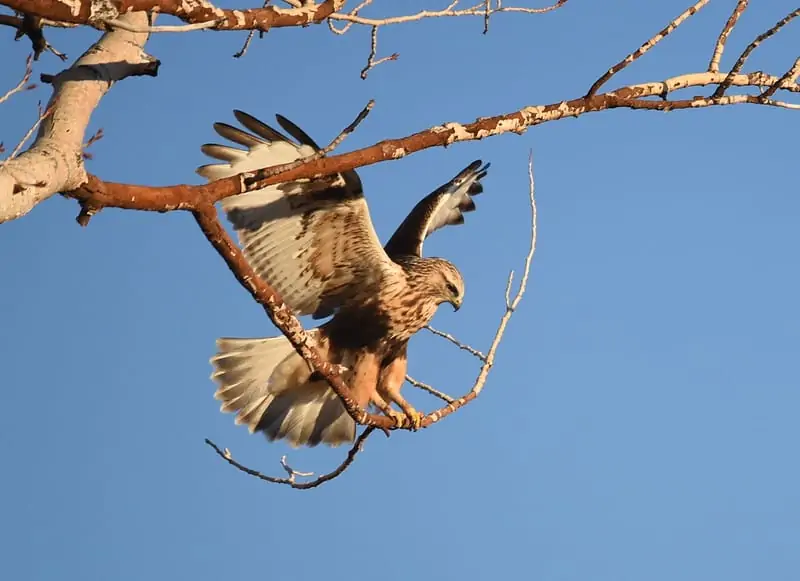
Scientific name: Buteo lagopus
Length: 18.5-20.5 in
Weight: 25.2-49.4 oz
Wingspan: 52.0-54.3 in
Throughout the fall and winter months, rough-legged hawks may be seen throughout Wyoming. They travel all the way to the northern Arctic when it’s time to breed! They’ll nest on cliffs and rocky outcroppings there.
They’ll be perching on poles and fence posts in the winter, especially in wide-open spaces. Mice, voles, and shrews are all on the menu here. Rough-legged hawks have been observed to hover in place by flapping their wings and turning into the wind. They may use this position to examine the earth below them for food.
The feathers on rough-legged hawks’ legs give them their name. Feathers that go all the way down a bird’s legs are rare in the United States. The majority of them have a thick black belly patch and are covered in heavily mottled dark brown and white. A black patch against a light backdrop will be visible in flight, resembling a wrist. A dark-morph, which appears to be two-toned from below, also appears to be nearly black.
7. SHARP-SHINNED HAWK

Scientific name: Accipiter striatus
Length: 9.4-13.4 in
Weight: 3.1-7.7 oz
Wingspan: 16.9-22.1 in
Sharp-shinned hawks may be found across Wyoming year-round and are the smallest hawk in the US. Small birds and rodents are prey for these hawks, which pursue them through the forest.
They stick to forests with thick canopy during nesting, making them difficult to see. They’ll hunt birds at feeders in the backyards on occasion. During the fall migration, however, is the best time to see them. They head south towards the United States. they are frequently seen at hawk watch locations during their summer range in Canada.
Sharp-shinned Hawks have a cream colored breast with black tail banding, and their back is blue-gray with reddish-orange barring. They have a more rounded head and squared-off tail than the cooper’s hawk, which makes them look quite similar.
8. SWAINSONS HAWK

Scientific name: Buteo swainsoni
Length: 18.9-22.1 in
Weight: 24.4-48.2 oz (
Wingspan: 45-55 in
Throughout the breeding season, Swainson’s Hawks may be found across Wyoming. During the summer, you can expect to see them in large swaths of open land. Telephone poles, wires, and secluded trees will all be used to perch.
Kettles, which are as big as tens of thousands of birds, are used to migrate hawks. You should take a look at these raptors during their migration if you’re interested in seeing Broad-winged hawks.
As their habitat has evolved throughout time, Swainson’s Hawks have flourished in agricultural settings. They can be found in crops and fields foraging for food.
Their head is gray, with a white chin, a brown bib, and a white belly that is speckled with rust. The brown chest and wings, which appear unusually lengthy with black borders, may be seen from below.
BONUS BIRD – THE OSPREY
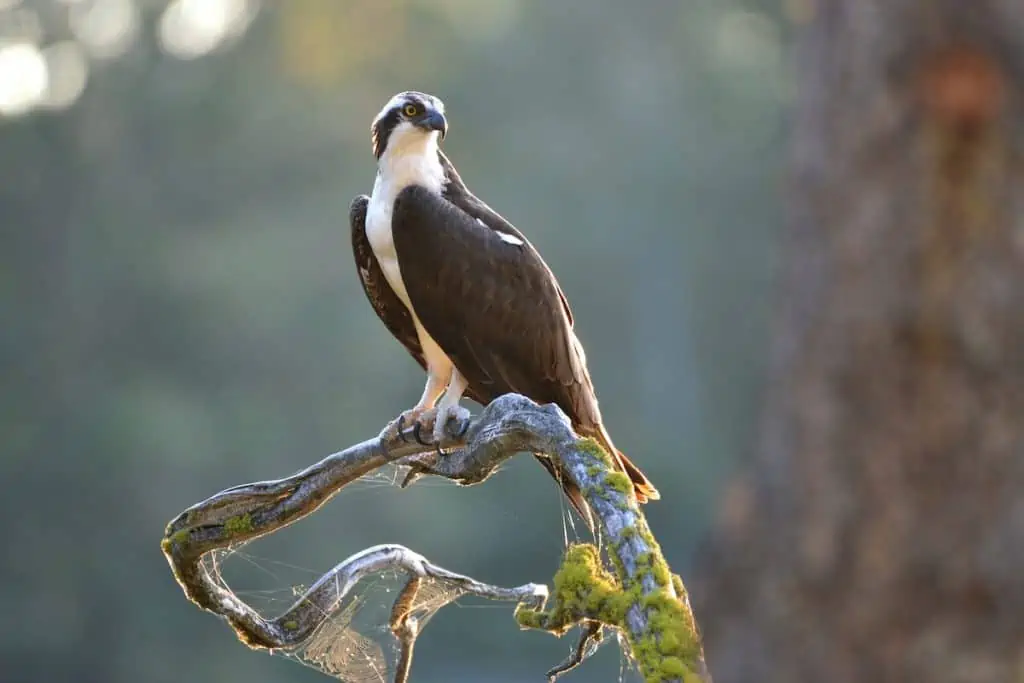
Scientific name: Pandion haliaetus
Length: 21.3-22.8 in
Weight: 49.4-70.5 oz
Wingspan: 59.1-70.9 in
They resemble a hawk and are closely connected, but osprey classification is genetically distinct enough to be classified as such. Since osprey feed almost entirely on fish, you’ll only notice this raptor if you’re near water. Their forward/backward-griping toe is located on the outside of their foot. Because of this adaptation, they have a much better grip on the slippery fish they capture.
Throughout the summer, Ospreys may be found in northern Wyoming, but during spring and fall migration, you may see them throughout the state. Around shallow, fish-rich waters such as lakes, rivers, reservoirs, and marshes you’ll find them.
They’re fairly easy to tell apart from hawks because of their coloring. Their beak is hooked, and their head is white with a large dark brown stripe across each eye. The underparts are pure white, and their back and wings are a dark brown color. Their wings have a dark brown patch at the “wrist,” which appears speckled when they’re flying.
Ospreys use human-made platforms as well as treetops or cliffs to build their nests. To help with the conservation of the species, many states have erected osprey platforms along rivers and lakes.
